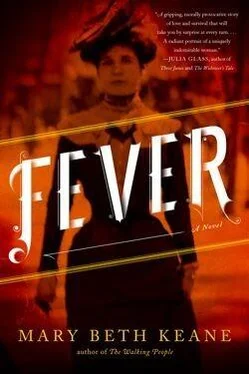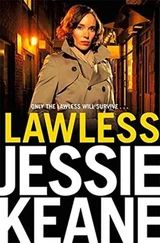After what felt like several hours of almost perfect stillness, she heard the creak of the fence door swinging open, the crunch of footsteps in the snow. Frank, she prayed. Come to tell her the coast was clear. She heard footsteps pass her little shed, the shadow of a man darkening the slim spaces of sky between the wood slats. A person was standing at the shed, facing it. Mary could feel the stranger sizing up the little structure, the perfect hiding place. “Mary Mallon,” a man called out. The world was thin, brittle, frozen solid, and the man’s voice threatened to crack everything open, smash all the lovely icicles hanging from branches. She pressed her lips together and closed her eyes. More steps approached to join the person already at the shed. A woman’s voice, efficient, fed up, stood out from the others.
“She’s in there,” the woman said, as if it should have been obvious to everyone, and in one last surge of hope Mary imagined her pointing her finger away from the storage shed to the trees, to the clouds.
“Mary Mallon,” a man said again, and it was the tone in his voice that told Mary it was over. He really did know she was in there, and he’d give her a moment to decide to come out before he went in and got her.
Someone pulled the lever that opened the door, and four men and one woman leaned in to look at her. Mary’s hips and knees felt like a kitchen scissors gone to rust.
“I’m not going anywhere,” Mary said as she worked to ignore the searing pain in her joints. “Leave me alone.”
“Mary Mallon,” one officer said. “You are under arrest. You have—”
She shoved him. She put her head down and threw out her arms and shoved him. When another officer approached, she kicked, and next thing she knew one was trying to pin her arms, while another had gotten her around her waist. She felt one at her ankles. She reached out and grabbed a handful of the woman’s hair. The snow in the Alisons’ backyard was churned up, and Mary felt the wet of her skirt through her thick wool stockings. One of the men caught her left arm, and when he did he twisted it around behind her back. When she turned to knee him, another officer grabbed her right arm. They lifted her, carried her across the Alisons’ small yard to the narrow path that ran beside the Bowens’ house. She tried to kick, to buck, to twist in their arms, raising her knees in the air and then letting fly with every bit of strength she had left, but she was stiff from sitting in the cold for so many hours, and her movements felt clumsy, poorly aimed. One of the officers was telling her to be quiet, relax, that she was only making everything worse for herself, and next to all of this buzzed Dr. Baker, who rushed up to the door of the truck and pulled it open so that the men could shove Mary inside.
• • •
Dr. Baker walked to the front of the courtroom. It was the pattern of the day; one description of Mary in a given moment was not good enough. They had to get two, three, four people up there to say the same thing. One of the police officers had already had his turn and had told them all about it, said Mary was an animal, worse than an animal because even the wildest animal can be coaxed, usually. There was no coaxing Mary that day. No reasoning with her. She was like no other person he’d arrested in his life. He had scratch marks on his arms and neck for days after.
As Mary observed the plain-looking woman turn to the judge before taking her seat, she knew it would look worse that she’d attacked a woman, and Dr. Baker was a smaller woman than Mary, and a woman of the class that allows women to become doctors.
But Dr. Baker surprised her. She admitted that she’d had to sit on Mary during the ride to the Willard Parker Hospital, but other than that she said simply that Mary had seemed frightened, and that the others had covered for her. “As anyone would expect them to,” she added, “being Miss Mallon’s friends.” No one else had said anything about her having friends.
“Dr. Baker, did you find her to be unreasonable?”
Dr. Baker hesitated. “We didn’t try to reason with her. When she went missing we focused on finding her, and when we found her we simply forced her into the truck. So I couldn’t comment on that. Other than two brief conversations we had when she was still being held at Willard Parker, I’ve never spoken to Mary Mallon at any length.”
“Wouldn’t you agree that a woman who hides in a shed for so many hours to avoid arrest has a guilty conscience?”
Again, Dr. Baker hesitated. “I would say that person doesn’t want to be arrested, guilty or not guilty. And I would say that none of us here would like to be arrested.” Dr. Baker stared out across the heads of all the witnesses in the gallery, her hands folded neatly in her lap. The attorney asking the questions searched through several sheets of paper and then pushed them aside and turned to Dr. Baker without notes.
“Dr. Baker, as a resident of New York City and as a medical doctor, would you feel comfortable letting Mary reenter society? Allowing her to leave North Brother Island and return to her former life?”
Dr. Baker frowned. She remained silent for a long time, and in the gallery the spectators wondered if she’d heard the question. Finally, she spoke. “It’s my opinion that Mary Mallon does not understand the medical threat she is to those around her. However, neither do many of the medical personnel who’ve become acquainted with her case in these past two and a half years. I can say only that I don’t think Miss Mallon should be allowed to cook. All the medical doctors in this room have admitted that she is a healthy person. What happens when more healthy carriers are discovered? Do we send them all to North Brother?”
Mr. O’Neill smiled in his seat. The other attorney frowned. “Dr. Baker,” the other attorney asked, “is it possible that you have particular sympathy for Miss Mallon because she is a female?”
Dr. Baker tilted her head and considered. “Perhaps.”
In the end it took several more days for the judges to decide what to do with her. Instead of sending her all the way back to North Brother for the night, they put her in a hotel with guards posted outside her room, and on the morning of the second day, ten minutes were wasted in arguing over who would foot the bill for such a luxury. The City of New York? Which department? One of the DOH representatives shouted, “That woman is expensive enough as it is.”
She spent three nights in the hotel all told, and except for the fact that her bed was made every afternoon when she came back from the hearing, it wasn’t that different from North Brother. The hotel laundry wouldn’t lend her an iron, so she gave in and sent her skirt and blouse downstairs for them to clean, which they did, in plenty of time for each morning’s proceedings. The mousy girl who brought up her clothes on the morning of the fourth day said, “Good luck to you, Missus. We hope they let you go,” and Mary imagined a whole staff of women standing behind her, rooting for her, waiting to hear what would happen.
And then, back in the oppressive courtroom, at ten o’clock in the morning of July 31, 1909, Judge Erlinger stared out across the heads of every man and woman in the room and announced that Mary Mallon’s release would be a hazard to every New Yorker and could not be justified. She would be returned to North Brother Island immediately.
Mary heard the words as a kick to the gut and gripped the table to steady herself. “What does it mean?” she demanded of Mr. O’Neill. Everyone in the room seemed to have woken up. Some of the reporters jumped from their seats to shout questions at the judge, at the collection of experts, at Mr. O’Neill, at Mary.
Читать дальше












